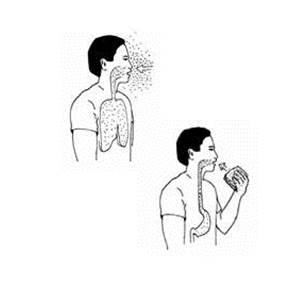-
 You can get lead into your body by breathing it in or swallowing it. You can breathe in lead when lead dust, mist, or fumes (“smoke”) are in the air. You can swallow particles of lead if lead gets on your hands, clothing, or face. You can also swallow lead if food, beverages, cosmetics, cigarettes, or tobacco products become contaminated with lead. A person who smokes contaminated cigarettes can both inhale and swallow lead.
You can get lead into your body by breathing it in or swallowing it. You can breathe in lead when lead dust, mist, or fumes (“smoke”) are in the air. You can swallow particles of lead if lead gets on your hands, clothing, or face. You can also swallow lead if food, beverages, cosmetics, cigarettes, or tobacco products become contaminated with lead. A person who smokes contaminated cigarettes can both inhale and swallow lead.
After a person inhales or swallows lead, it is absorbed into the bloodstream and then circulates throughout the body. About half of the lead that is absorbed is removed right away by the kidneys into the urine. The lead that is not removed is stored in the body. Most of this lead gets stored in the bones and may stay there for years. Lead in bone is slowly released back into the bloodstream over time. Because lead is stored in the bones, exposure to even small amounts of lead over a long period of time can be harmful.
-
Lead damages the brain, nerves, red blood cells, kidneys, and reproductive systems of men and women. Lead easily crosses the placenta in a pregnant woman and can harm the fetus. Lead can also cause high blood pressure, miscarriage, and other serious health problems and increases the risk of death related to heart disease or stroke. Damage from lead exposure can be permanent.
There are many signs and symptoms of lead poisoning, and they can easily be confused with symptoms of other conditions. The blood lead level at which symptoms occur is different in each person. Some people with lead poisoning have no symptoms.
Some symptoms of adult lead poisoning are shown below:

Note: This is not a complete list of symptoms. A doctor with experience caring for lead-exposed workers must decide if an employee's symptoms are related to lead exposure.
-
The best way to know if there is lead in your body is to have a blood lead test. A blood lead test will tell you whether you have been recently exposed to lead either by breathing or swallowing it. If you work with or around lead, you should be tested periodically for lead.
A blood lead test must be ordered by a doctor. Blood lead test results are reported as micrograms of lead per deciliter of blood (μg/dL or mcg/dL). The typical blood lead level for adults in the U.S. is less than 1 μg/dL.
If you think you may be exposed to lead, ask your doctor to do a blood lead test. If you work with lead, your employer may be required to offer this testing. See
Workplace Hazard Alert - Health Dangers from Lead (PDF) for more information on what your employer must do to protect you.
-
Some of the harmful effects of may occur at very low levels. Scientists and doctors now recommend that blood lead levels be kept below 3.5 μg/dL.
-
The main treatment for lead poisoning is to remove the person from lead exposure to allow the body to clear the lead.
In cases where a worker has a dangerously high level of lead in their body, the employer is required to transfer that worker to another job where the worker won’t be exposed to lead, or to take the worker off the job. The worker must stay away from lead work until the blood lead level comes down. This is called Medical Removal Protection, and is ordered by the doctor. Workers who are on Medical Removal Protection receive their full salary and benefits, and can only return to their regular job if their doctor approves.
In rare cases, adults with very high blood lead levels and serious symptoms may need treatment with a drug to help lower the lead in the body. This is called “chelation therapy.” Only a licensed doctor with experience treating adult lead poisoning should make decisions regarding chelation for an individual worker.
-
Lead brought home from work on your clothes and shoes can expose your family to dangerous levels of lead. This “take-home” lead can harm children or other adults in your home. If you think that you may have brought lead home, your family and others who live in your house should also have their blood tested for lead. If you need help getting a blood lead test for a family member,
contact your local Childhood Lead Poisoning Prevention Program.
For more information about “take-home” lead, see our brochure “Don’t Take Lead home From Your Job!” in
English (PDF) or
Spanish (PDF).